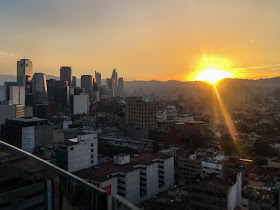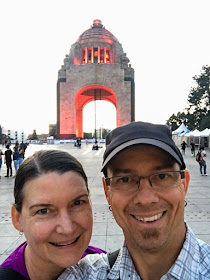
These are El Torito’s beef tacos, specifically campechon, suadero and tripa.

Another day we had beef tongue and cheek tacos topped with nopales at El Huequito.

The restaurant had a wide variety of meats available for tacos.

For our second round we tried spicy sausage and pork suadero tacos.

One morning we stopped for a churros. He was pulling a fresh batch out of the fryer as we ordered.

We shared an order of churros and Spanish chocolate for dipping.

Pete has dipped his first churro and is ready to enjoy.

We walked a lot in CDMX. Here’s a fruit stand in Mercado San Juan. The mangos and figs were especially good.

As we walked we spotted these interesting thick black tortillas cooking so we stopped to investigate.

This nopales taco was really spicy because Kristina went overboard with all the salsas.

Tacos al pastor was another lunch. The pork is seasoned with guajillo chilies and pineapple is served with the tacos.

Roasting the pork on a vertical spit shows Lebanese influence on Mexican cuisine.

CDMX has lots of colorful street art.


This multi-eyed figure was recreated a dozen times on a block.

We toured Luis Barragán’s home and studio. We didn’t know much about him except that he won the Pritzker prize for architecture and his home was a UNESCO World Heritage site.

When we arrived we were surprised that the exterior of the house was so plain.

But we fell in love with the simple, elegant beauty of the interior. This is the living room, with high ceilings and huge windows out to the garden.

This is the Nudo Negro kitchen with cooks in action. On the left is Chef Daniel Ovadía.

He had worked in kitchens in Thailand and Singapore so his menu had international influences. We enjoyed chatting with him in the kitchen while we ate our first course: satay skewer of wagyu beef with peanuts and chilies.

We ate the nine course tasting menu, and almost every dish was outstanding. This oyster had an Indonesian sambal sauce and a dollop of wasabi.

In front of us is Nudo Negro’s take on chawanmushi, a Japanese savory custard.

This duck dumpling was swirled with a rich almond cream and served on roasted mushrooms, onions and green beans.

The tender pork rib had Jamaican jerk seasonings and was served atop crunchy bean sprouts and a creamy bean paste. Luckily the portions were reasonably sized so we could enjoy every morsel.

For desert Pete had green tea flan with a scoop of sorbet.

We stayed in the Tabacalera neighborhood near the historic center that is home to many government offices. The horse sculpture behind Kristina is named El Caballito by Enrique Carvajal.

The Art Deco style Lottery building was completed in 1945, but the lottery in Mexico dates back to the 18th century and the Spanish colonial period.

This is Monumento a la Revolución Mexicana (MRM), which has had a rocky road to existence. The building originally planned in 1897 was to be a federal legislative palace to celebrate the centennial of Mexican independence. But construction was interrupted in 1910 by the Mexican Revolution and it was unfinished for twenty years. In 1936 it was redesigned in Mexican modern architecture style as the MRM and an elevator was installed so people could go up into the tower. In 1970 the elevator was deemed unsafe, and it was closed for for 40 years. In 2010 the glass elevator was installed and the MRM reopened to celebrate the bicentennial of Mexican Independence and the centennial of the Mexican Revolution.

This photo shows the sculptures by Oliverio Martínez. This side is the Reform Laws with a women holding the sword of justice while two men hold books of the Mexican Constitution. (Click the photo to see it enlarged for a better view of the sculpture.)

We took the elevator up to the first observation decks. Then we climbed up to the 360 degree viewing platform. It was interesting to climb up inside the dome.

It was late afternoon when we visited and the copper dome was beautiful in the soft sunlight.

This was our view as the sun was setting.

We climbed and rode the elevator down, then enjoyed dusk in the plaza as the lights in MRM came on.

Sixty-seven meters high, MRM is the tallest triumphal arch in the world.

Looking up at the elevator as night fell, we were glad that the glass elevator had been installed in 2010.

Around CDMX we’ve seen lots of beautiful blooming jacaranda trees.

Behind the fountain is the Kiosco Morisco de Santa María la Ribera.

Built of wrought iron for the 1886 World’s Fair in New Orleans, the Morisco Kiosk was installed its current location in 1912.

The park and kiosk host numerous musical groups in the wonderful eight-sided bandshell. The Morisco Kiosk was completely renovated in 2003.

Across the street is the Geology Institute. This is the impressive Art Nouveau staircase in the lobby, which was as much as we saw of the building because it was time for us to head to Puebla.

We left CDMX and took a bus two hours south to Puebla. This was our hotel in the charming historic district.

Our hotel room was great, with over five meter high ceilings and colorful walls.

We enjoyed walking around looking at all the colorful buildings.


We saw lots of buildings adorned with Talavera tiles, a style originating in Puebla that is named after a city in Spain.



Our noses led us to our first meal in Puebla, pozole, a rich chili soup of pork and corn topped with lettuce, onions and lime juice - yum.

Pozoloria Matamoros restaurant’s pozole is so popular that they sell packages of it.

We didn't have a lot of time in Puebla, so we decided to take a street food tour to sample their finest. Here we are with our guide Aleyn.

Aleyn told us in the 1930s Lebanese immigrants settled in Puebla. Their influence on food was present at El Sultan that serves spit-roasted pork al pastor and pork with onions.

These are tacos al pastor.

At El Sultan the pineapple is served on the side, along with onions and cilantro. On the left is a taco Árabe with jocoque, Greek-style yogurt with olive oil and salt that tasted delicious.

Aleyn took us to the Puebla market and explained that it's a great place to get street food. First we walked around admiring the produce. These are nopales, cactus that are related to aloe vera plants and naturally lower cholesterol.

These are Christmas beans that are traditionally served on the holiday.

There are so many different types of chilies. It’s interesting that the fresh name for the chili is different from its name for the dried version.

This is huitlacoche, corn fungus.

We tried huitlacoche in a molote, a pastry that was similar to a turnover. Huitlacoche tastes like mushrooms and we liked it a lot.

In the market we watched sandwich-making in action.

This bowl of pickles was curing. We could see different fresh chilies in the bowl.

And here's the finished sandwich: semita de milanesa. We loved the sesame roll (baked in pizza oven) with pounded, breaded and fried pork, avocado, quesilla cheese (from Oaxaca), chipotles, pickles and pápalo, a tasty herb.

In nearby Zacatlán they grow a lot of apples. At store Manzanini-Dolce Tentazione their windows were filled with spice-covered apples.

Kristina has a sliced chamoy covered apple. Chamoy is a salty-sweet-sour-spicy sauce that is the Mexican variation of Japanese umiboshi. It’s amazing!

We liked the chamoy apple so much that we also tried chamoy with nieve. Nieve is sorbet. Here you see mango sorbet in a cup that’s lined with dried chamoy. The nieve is dusted with chili powder, then liquid chamoy is put into the nieve. It’s salty-sweet-sour-spicy flavors are intense and wonderful.

We are glad we took the food tour! Aleyn is a native Pueblan and avid cook, so we learned a lot from her.

The Plaza Mayor in Puebla is beautiful at night. This is the Puebla Cathedral.

There were lots of people strolling in the plaza, and plenty of balloon vendors too.

Next we head to Oaxaca.
